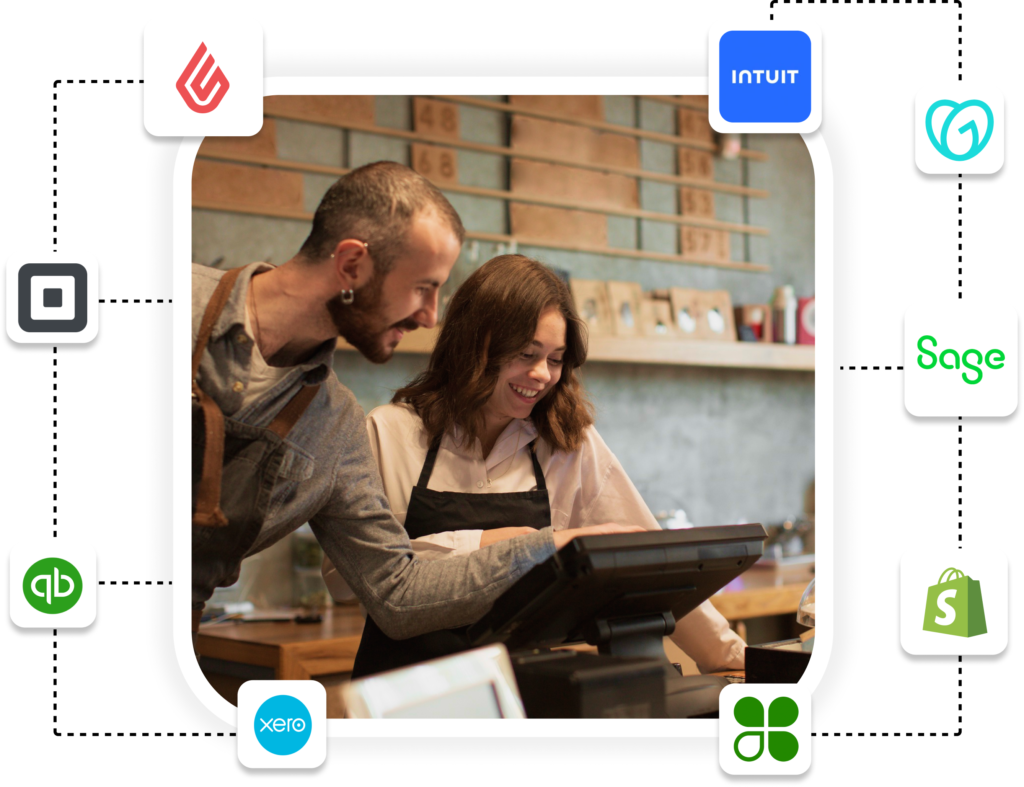
12.13.2023
In the dynamic world of restaurant technology, where integration complexities often impede efficiency and innovation, LINK emerges as a game-changer. With a focus on providing seamless technology integration, LINK, which recently closed a $5 million funding round, is tackling the daunting challenge of managing the myriad of applications a restaurant operates, from order systems to inventory management. In this interview, Sriram Subramanian, the Founder and CEO of LINK, explores some of the operational headaches that restaurants commonly face when it comes to technology integration and explains the role his company’s solutions play in alleviating those headaches.
Can you tell us a bit about LINK? What challenges does LINK aim to address in the restaurant industry? How does LINK’s solution contribute to enhancing the customer experience in restaurants?
 LINK is all about solving the tech integration issues which make life easier for restaurants. Think of all the different tech applications a restaurant uses – like the system for orders, tracking inventory, and managing tables. Depending on the size of the restaurant or chain, they could run up to 50 or even 100 separate applications. Too often, these don’t talk to each other well, which can be a headache. LINK steps in to make sure they all work together smoothly, which means improved functionality for the software companies, better service for customers and less stress for the restaurant team. We also know that sometimes restaurant owners are put off from even trying out new technologies which could be transformative, because of integration concerns. Our solution allows businesses to ‘plug and play’ much more easily, fostering innovation and increasing efficiency.
LINK is all about solving the tech integration issues which make life easier for restaurants. Think of all the different tech applications a restaurant uses – like the system for orders, tracking inventory, and managing tables. Depending on the size of the restaurant or chain, they could run up to 50 or even 100 separate applications. Too often, these don’t talk to each other well, which can be a headache. LINK steps in to make sure they all work together smoothly, which means improved functionality for the software companies, better service for customers and less stress for the restaurant team. We also know that sometimes restaurant owners are put off from even trying out new technologies which could be transformative, because of integration concerns. Our solution allows businesses to ‘plug and play’ much more easily, fostering innovation and increasing efficiency.
How does LINK’s approach simplify the digital landscape for restaurant businesses? How does LINK’s solution support restaurants in adapting to new technologies?
Running a restaurant is hard enough without tech troubles. LINK helps by tying all the digital tools a restaurant uses into one neat package. This way, restaurants can easily add new tech without causing a stir in their daily operations. LINK also supports restaurants by ensuring that new technologies can be easily and quickly integrated into their existing ecosystem.
Can you explain the concept of iPaaS in layman’s terms? What sets iPaaS apart from other technologies that have been introduced to the restaurant industry?
iPaaS, or Integration Platform as a Service, is like a universal translator for computer programs. It helps different software applications, which normally might not understand each other, work together seamlessly. This is super handy in restaurants where different types of software need to communicate to keep everything running smoothly.
Can you tell us more about LINK’s new Onboarding-as-a-Service vertical? How does this service improve the customer experience for new users?
The Onboarding-as-a-Service vertical is specifically designed to streamline and automate the onboarding processes for clients of new software applications. While this service is targeted toward technology companies, it is a breakthrough for restaurant owners. In our experience, the restaurant industry faces an ongoing, daunting task of integrating new software applications. This complexity can be a barrier to adopting new technologies that could be transformative for the industry. LINK’s Onboarding-as-a-Service addresses this challenge by managing the entire onboarding process, including customer support, training and the automation of historical data migration for menus, customer databases, and sales.
Can you tell us more about the new integrations that LINK has incorporated? What are your plans for the future in terms of new integrations?
In 2023 we expanded the portfolio to include all major system categories (ordering, accounting, loyalty, marketing and inventory management). This makes it possible for both app providers and restaurants to leverage us as a single point solution. We have also developed a first of its kind no-code framework which is able to generate new connectors and integrations orders of magnitude faster than traditional development models. In 2024 and beyond our vision is to support the long tail of restaurant and hospitality apps which we hope will democratize access to integration and migration technology for the entire ecosystem.
Can you share some details about LINK’s data migration technology?
LINK’s migration tech enables operators to switch to any apps of their choice without having to worry about leaving their data behind. Our platform enables automated migration of all essential data, which has historically been a huge pain point for the industry. We have partnered with leading POS, Accounting and Ordering systems to drastically reduce the onboarding time and support hours needed. Our goal is to enable restaurants to keep trying out new apps so that they can have the right tech stack aligned with business needs at any point.
How does LINK work with key applications and software systems?
LINK works by creating seamless connections between key applications and software systems used in restaurants. Our integrations ensure that data is accurately and promptly shared between systems, from POS to inventory management and CRM, enhancing overall operational efficiency.
Can you share some insights into your background before founding LINK? What inspired you to venture into the field of restaurant technology? How has your previous experience influenced the creation and development of LINK?
Reflecting on my inspiration for delving into restaurant technology, it traces back to my days at PayPal. There, I worked closely with small merchants, including many restaurant owners, and noticed their struggles with adopting and integrating their tech stacks. This challenge was not isolated but a recurring theme among small business owners across almost 20 countries. It struck me as a significant, yet unsolved global issue.
What really pushed me towards founding LINK was my realization that these small restaurant owners, especially those most in need of tech support, lacked accessible solutions. This gap in the market was evident and I felt compelled to address it. My prior experience at the security startup Trustgenix, which was later acquired by HP, also played a pivotal role. At Trustgenix, I was involved in adapting an enterprise-scale product for the SMB market. This successful venture highlighted the necessity and impact of bringing enterprise-grade technology to smaller businesses.
My mission with LINK became clear: to democratize access to advanced technology for small and mid-sized players in the restaurant industry. I aimed to provide a holistic solution that was previously missing, focusing specifically on empowering smaller restaurant owners to scale efficiently through technology.
Can you tell us more about LINK’s journey since its inception in 2019? How has the vision for the company changed, if at all, over the past 5 years?
Since LINK’s inception in 2019, our journey has been marked by significant evolution. Initially, we focused on retail-centric integrations, leveraging our team’s expertise in this area just before COVID-19 struck. However, the pandemic shifted the landscape, highlighting opportunities in the food industry with the rise of ghost kitchens and contactless payments. This led us to pivot towards building a platform-level capability, aiming to serve a broader range of merchants.
By 2021, we had developed a new architecture to support this vision, and by 2022, we successfully deployed it, validating our platform with several Fortune 500 clients and managing deployments for over 10,000 merchants. This strategic shift allowed us to expand beyond retail, scaling to multiple verticals and adapting to the rapidly evolving market and technological advancements.
How did last year’s $5 million funding round come about and what has been the impact on LINK’s technology platform and growth strategy?
Last year’s $5 million funding round for LINK was a pivotal development, emerging from our collaborations with accelerators and an advisory network, as well as our presence on a crowdfunding platform. This approach attracted a solid group of angel investors and early-stage funds, enabling us to secure the funding without a traditional institutional process.
The impact of this funding has been substantial for LINK’s technology platform and growth strategy. It has accelerated our readiness for scaling, leading to significant client acquisitions and the prospect of supporting 80,000 merchant businesses by 2024. A major focus area, fueled by this funding, is the advancement of our no-code platform. We’re working to significantly reduce the time for new integrations, aiming to transition from several days to just a few hours. This enhancement, backed by our machine learning and AI efforts, is geared towards making it highly efficient and affordable for small businesses to adopt new technologies. Our goal is to have thousands of new connectors ready in the next 2 to 3 years, marking a major leap in our technological capabilities and market expansion.
Can you explain the concept of “Automation by Integration”?
“Automation by Integration” is our way of saying that when all your software works together perfectly, a lot of things can be done automatically. This means less manual work and more time focusing on what’s really important – like making customers happy.
Can you explain how LINK’s solution can serve as an ancillary revenue stream for Application Service providers?
LINK’s solution enhances client retention and attracts new clients for Application Service Providers by ensuring seamless integration with the latest software applications. This capability is crucial, as failing to integrate can result in losing existing clients and hindering new client acquisitions. Additionally, LINK’s efficient historical data migration eases the transition for new clients, addressing a common concern. Operational benefits include speeding up new client activation by 20% and reducing internal support costs by over 80%. Furthermore, LINK supports generating ancillary revenue by offering options for providers to charge a recurring fee for integrations, adding a valuable revenue stream and enhancing service offerings.
What are LINK’s plans for the future, considering the exponential growth it has experienced to date? Any new product releases, partnerships, etc., on the horizon you can share?
We have several exciting projects in the pipeline. We’re exploring innovative product releases and potential partnerships that align with our vision to help small businesses grow and thrive. There’s a lot brewing behind the scenes, and we can’t wait to share these developments with you soon.

